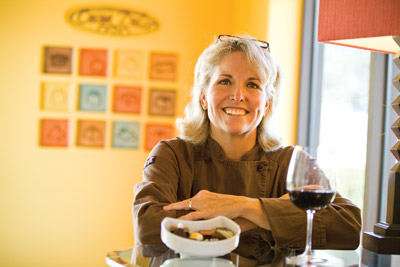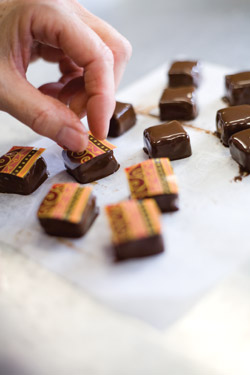
An age-old obsession, it was used by the Maya and Aztec as money and in royal and religious rituals. It’s made fortunes for some, the Ghirardellis, Nestlés and Hersheys among them.
And it seems it’s always counted, along with jewelry and flowers, as one of the truest gifts with which to complement love — chocolate.
Robert McClarty is a man on a mission. The Hutchinson, Kan., resident had gotten a tip about a unique Wichita shop, where the handcrafted chocolates are out of this world.
“Great! This will work,” he thinks, as he steps into Cocoa Dolce on a search for a birthday gift for his daughter and a wedding anniversary present for his wife. He carefully looks over the selection of chocolates. This won’t be an easy decision. There are simply too many tempting options.
Beth Tully ’76 is the shop’s owner, operator — and Kansas’ only master chocolatier. One recent morning at Cocoa Dolce, she’s seen carefully measuring the temperature of a batch of chocolate. “Just right,” she says and proceeds with the next batch. Chocolate, she explains, is a “finicky substance” to work with, but the challenge fascinates her.
Tully’s conversational tone is pleasant, quick and efficient. Attired in a brown chef’s jacket, she swirls topping onto a neat row of chocolates. Observing the scene, you might surmise that she’s run her business for decades, but that’s not the case. It took some unusual twists and turns to reach this point in her professional life.
A Delta Gamma member while a student at WSU, Tully earned a bachelor’s degree in speech therapy. She also learned the importance of some key intangibles. As she puts it: “My days at WSU taught me the importance of friendship, hard work and being true to oneself.” She went on to graduate school at the University of Michigan, worked in her discipline for a number of years and then shifted to the corporate world, becoming a regional account manager for Coca-Cola.

chocolates at Cocoa
Dolce in Wichita.
Then about four years ago and fast approaching her 50th birthday, Tully reflected about what she really wanted to do. What could give her the deepest sense of professional satisfaction? Her answer was in chocolate. The mysterious, nearly magical pull chocolate has on people is unlike that of any other foodstuff — and one she finds powerfully attractive. “Chocolate has a universal appeal,” she says. “People can have almost mystical responses to it.”
Elizabeth Somer, a registered dietitian and author, proposes that chocolate, which is not a member of any food group, symbolizes “an escape from day-to-day drudgery.” Furthermore, she explains, certain compounds found in chocolate not only cause the release of endorphins in the brain (thus, providing a mental boost), but also stimulate the nervous system and increase blood pressure and heart rate — all reactions that are similar to being in love.
Before deciding to make and sell chocolates for a living, Tully had long been creating chocolaty confections to the high acclaim of family and friends, including WSU First Lady Shirley Beggs, who is proud of Tully’s accomplishments and often buys Cocoa Dolce chocolates as gifts. But entering the chocolate business called for Tully to learn new skills.
She first set up an appointment at the Kansas Small Business Development Center at WSU, where she met Ken Elliott, a KSBDC consultant. “You really have to like what you’re doing and not go into it just to make money,” he counsels.
Tully’s next step was to obtain certification as a master chocolatier. For her formal education, she attended Vancouver’s Ecole Chocolat Professional School of Chocolate Arts, one of only four schools of its type in North America. There, she excelled. In fact, Pam Williams, the school’s founder and president, places Tully among the 30 best chocolatiers in the country, citing her “passion for the industry and her desire to dedicate the time and energy needed to be the best she can possibly be.”
And so, Tully, now in elite company, was primed to open Cocoa Dolce in Sienna Plaza, 7730 E. 37th Street. Its doors swung open in December 2005. Like life, however, not everything went as planned. On the shop’s first day of business, the cash register didn’t work, and Tully ended up giving her products away. She says with a laugh: “We made a lot of friends that day.” With an average price of $1.65 each, Cocoa Dolce chocolates aren’t inexpensive. But much to Tully’s relief, the price hasn’t met much customer resistance. Taking into account that every chocolate is handmade with only premier ingredients and that extraordinary attention is paid to taste and finish, the charge seems a fair price.

Cocoa Dolce is to "wow
people at first bite."
Most customers take their time in savoring the culinary experience, and Tully’s master chocolate-making is winning an ever wider audience. Cocoa Dolce chocolates — specifically the “Cranky Jack-o-Lantern Assortment” — will be featured in Dean & DeLuca’s fall catalog, which is mailed to 750,000 potential customers. (In a Shocker-to-Shocker connection, the owner of Dean & DeLuca is Leslie Rudd ’81.)
Karen Bloom has been Tully’s close friend for more than 30 years. Bloom, president of the Chicago-based executive search firm of Bloom Gross & Associates Inc., is more familiar with computers than crafting chocolates, but she worked alongside her friend during one recent holiday break. “You’re standing on your feet all day and each piece has to be perfect,” she says. “I haven’t worked that hard in years.”
Tully reports, “Chocolate takes on its own life, and you have to treat it just right. It’s not all fun and games.” One challenge is shipping the perishable product, and with the growing popularity of the business’ Internet site, that’s a priority. Cocoa Dolce uses a custom insulated package to help prevent melting.
Although Tully uses traditional European technologies and equipment, she also follows her own muses in creating chocolates: “creativity, passion and playfulness,” which infuse her chocolates with their own unique flavors and look. For one, consider what is called the “Mayan.” A 57 percent bittersweet ganache, it combines vanilla, cinnamon, honey and ancho chili pepper.
The ultimate judge, the market, seems to agree with Tully’s take on chocolate-making. Cocoa Dolce has proven such a success, in fact, that she’s expanded her venture to include a nearby 1,875-square-foot production facility and renovated the shop itself to incorporate more seating and a wine bar. Williams says, “We think that you can only get excellent chocolate in New York or Paris,” Williams says. “But that’s not true.”
For her part, Tully simply reports, “I’m just happy. I’m doing what I want to do.”
-- Contributing Connie White
2500 Years of Chocolate

- 1400-1100 B.C.
Oldest known evidence of T. cacao cultivation and consumption, discovered
in Puerto Escondido, Honduras, in 2007. - 600-1500 A.D.
Cacao beans are used as currency by the Maya and Aztec. - 1502
Christopher Columbus brings chocolate back to Spain, where sugar is added
to it for the first time. - 1657
A Frenchman opens the first chocolate shop in London, selling it at 10-15 shillings a pound—the equivalent of about $880. - 1875
Henri Nestlé develops a powdered-milk infant formula, soon adapted for use
in milk chocolate. - Feb. 9, 1894
Milton Snavely Hershey founds his eponymous chocolate company in what is then known as Derry Church, Pa. The Hershey’s Kiss is introduced 13 years later. - 1937
Chocolate bars become standard-issue rations for U.S. military personnel. In the late 1980s, the Army invents the Congo Bar, which can withstand temperatures in excess of 140°F. - 1964
Roald Dahl publishes Charlie and the Chocolate Factory, a tale of fantastic confections and the bratty children who love them. - 1976
Concern over suspected carcinogen FD&C Red #2 prompts the elimination of red M&Ms — despite the fact they never contained the dye in the first place. The candies were reinstated in 1987. - Aug. 2003
Two studies suggest that dark chocolate is a potent antioxidant and may help lower blood pressure. Millions claim they’d known it all along.
— Anna Perleberg fs ’05





